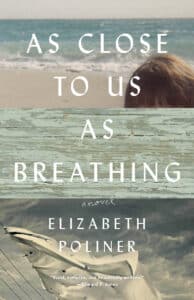Novels for the New Year
September 8, 2016 in Library Corner
By Robin Jacobson.
A round of applause for congregant Michelle Brafman! Beth El proudly announces the September publication of Michelle’s second full-length work of fiction, Bertrand Court, following the success of her earlier novel, Washing the Dead (2015).
Bertrand Court is about connections – between family members and friends, between the past and the present. Coincidentally, I read Bertrand Court while also reading another perceptive new novel with similar themes, As Close to Us as Breathing by Elizabeth Poliner. This turned out to be a wonderful pairing, one I recommend. Both authors are close observers and sensitive chroniclers of the nuances of human relationships. The books are a pleasure to read.
Bertrand Court
 Part of the fun of Bertrand Court is that the action is set in familiar territory. The book is a set of interlinked short stories about a group of mostly Jewish friends and relatives; many of the characters live on a cul-de-sac (Bertrand Court) in the suburbs of Washington, D.C. The characters eat Asian food at Spices, shop at Montgomery Mall, stroll along the canal in Georgetown, and read The Washington Post.
Part of the fun of Bertrand Court is that the action is set in familiar territory. The book is a set of interlinked short stories about a group of mostly Jewish friends and relatives; many of the characters live on a cul-de-sac (Bertrand Court) in the suburbs of Washington, D.C. The characters eat Asian food at Spices, shop at Montgomery Mall, stroll along the canal in Georgetown, and read The Washington Post.
Brafman skillfully transitions from story to story, showing us the characters from different perspectives – a narrator in one story may be a bystander in another. The characters confront a variety of challenges, some humorous, some wrenching: a bratty five-year-old, multiple miscarriages, the failure of a family business, the death of a parent.
The most exuberant inhabitant of Bertrand Court is Becca Coopersmith. She eagerly embraces hot yoga, pole dancing, Kabbalah, and a women’s drum circle. Around her backyard fire pit, she gathers her girlfriends to spill their souls. And on Shabbat, Becca lights candles, “blessing the hell out of life.” She is irresistible, as is this book.
As Close to Us as Breathing
 Like Bertrand Court, this novel presents a slice of Jewish life, but it is a darker work about family and obligation and guilt. Stunningly, the novel opens with Molly, the narrator, disclosing that her younger brother died when she was twelve:
Like Bertrand Court, this novel presents a slice of Jewish life, but it is a darker work about family and obligation and guilt. Stunningly, the novel opens with Molly, the narrator, disclosing that her younger brother died when she was twelve:
The summer of 1948 my brother Davy was killed in an accident with a man who would have given his own life rather than have it happen.
As the novel progresses, we learn the family history that preceded and followed Davy’s tragic accident in a Jewish beach community (“Bagel Beach”) in Connecticut. At the story’s center are three sisters: Vivie, Ada, and Bec. They spend summers at the family beach cottage with the kids; the husbands arrive each Friday in time for Shabbat dinner. The middle sister, Ada, is married to Mort, who was once Vivie’s beau. The sisters are reconciled, but the fact that Ada stole Mort from Vivie leaves a residue of bad feeling. Bec, the youngest sister, is single, a talented dress designer torn between her family and a secret love affair with her married, Catholic boss.
As Close to Us as Breathing is a coming-of-age story for Molly and other teenagers in her extended family. But it is also social history; the lives of the three sisters illustrate the constraints on American women in the 1940s in education, employment, and even mobility (the sisters depend upon men who drive). Most memorably, the novel portrays the dynamics within a family. It takes a new, insightful look at the old question of what we owe to family versus what we owe to ourselves. Something worth pondering as the High Holidays approach.